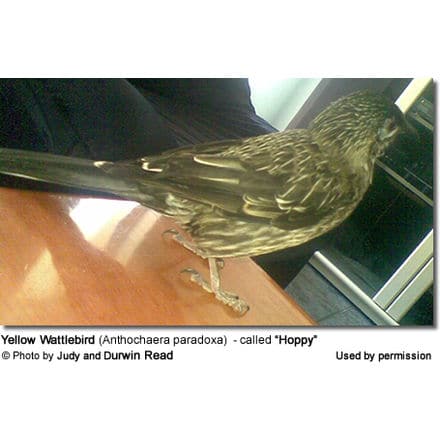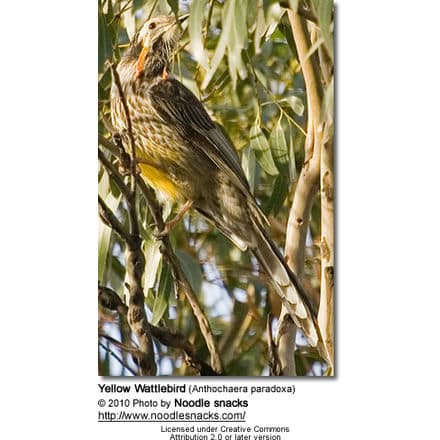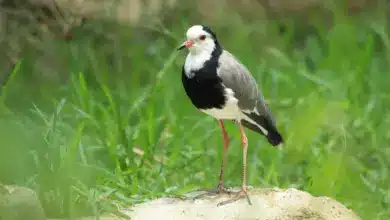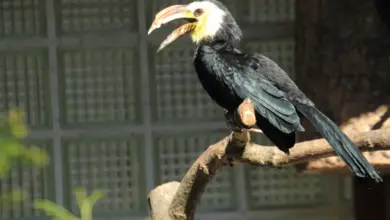Yellow Wattlebirds
The Yellow Wattlebird (Anthochaera paradoxa) is also known as the Long or Tasmanian Wattlebird.
Distribution / Range
Yellow wattlebirds are common in Tasmania, especially in the eastern and central areas. They are also found on King Island and 2 sightings have been recorded on the South Mornington Peninsula in Victoria.
Yellow wattlebirds live in a variety of habitats including both dry and wet forests and from sea level to the subalpine zone. They live in coastal heaths, forests, and gardens near eucalyptus trees.
They also can be found in mountain shrubberies and open woodlands, particularly those dominated by banksias.
They have also been known to be found on golf courses, orchards, parks, and gardens.
Alternate (Global) Names
Czech: Kvetosavka žlutá, lalo?natka tasmánská … Danish: Gullappet Honningæder … Dutch: Geellelhoningeter, Geellel-honingeter … German: Gelblappen-Honigfresser … English: Yellow Wattle Bird, Yellow Wattlebird … Spanish: Filemón Amarillo, Mielero Ventriamarillo … Finnish: Keltahelttamesikko … French: Méliphage à gorge-chiffon, Méliphage à pendeloques … Italian: Bargigliuto giallo, Mangiamiele dalle caruncole gialle … Japanese: kimimidaremitsusui … Norwegian: Gyllenflikhonningeter … Polish: koralicowiec zólty, koralicowiec ?ó?ty… Slovak: medárik velký … Swedish: Gul kråsfågel

Description
The yellow wattlebird is the largest of the honeyeaters and is endemic to Australia. They are usually 375-450mm long. The female yellow wattlebird is much smaller than the male.
They are named for the long, pendulous yellow-orange wattles in the corners of their mouths. The wattle becomes brighter during breeding.
Yellow wattlebirds are slim birds with a short, strong bill. They are dark-colored forest birds that somewhat resemble slandering Grackles. They have white faces and black-streaked crowns. They have dark wings and a yellow belly whereas the upperparts are grey to dusky brown.
The young yellow wattlebirds have much smaller wattles, a paler head, and a browner underbelly than the adult birds.
Yellow wattlebirds are active and acrobatic with a strong flight. They are fairly tame birds and often enter gardens looking for food.
Similar species
They resemble the Little Wattlebirds
Pet Potential
Judy and Durwin are the proud “parents” of a Yellow Wattlebird” called “Hoppy” featured above. They describe their experience of her as a pet: “[H]er name is hoppy because she used to hop around the house before she learned to fly. Also, she used to run flat out and open her wings like a plane to take off took about two weeks before she could fly. She is a most amazing girl and gives us great pleasure.”
Calls / Vocalizations
Harsh, raucous, has often been compared to a person coughing or vomiting.
Breeding
Yellow wattlebirds nest in breeding pairs and aggressively defend their territories from other birds. The nest of the yellow wattlebird is made by the female alone and is a large, open saucer-shaped structure made of twigs and bark that are bound by wool.
The inside of the nest is lined with wool and grass. The nests can be up to 13 cm high and are found in trees or shrubs. Yellow wattlebirds lay 2-3 eggs that are salmon red, spotted and blotched red-brown, purplish red and blue-grey. Both the males and females incubate the egg and feed the young.
Diet / Feeding
Yellow wattlebirds feed on the nectar of eucalypts and banksias, fruit, insects, spiders, honeydew, and manna.
They forage from all levels of the canopy from the ground to the top of the trees. However, the blossoming of eucalyptus trees can be highly irregular in time and place causing considerable changes from year to year in the breeding distribution of yellow wattlebirds which rely on the nectar from the eucalyptus trees as a main source of food. Therefore, the most likely threat to the yellow wattlebird is unusual climatic conditions that can reduce food availability suddenly. Also, it is important to note that yellow wattlebirds are pollinators of eucalyptus trees by carrying pollen in both their bills and head feathers.





